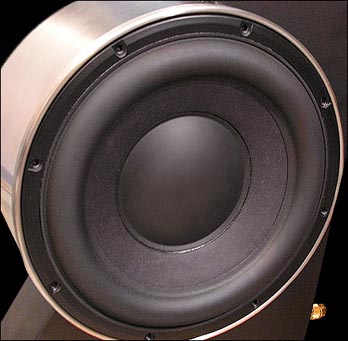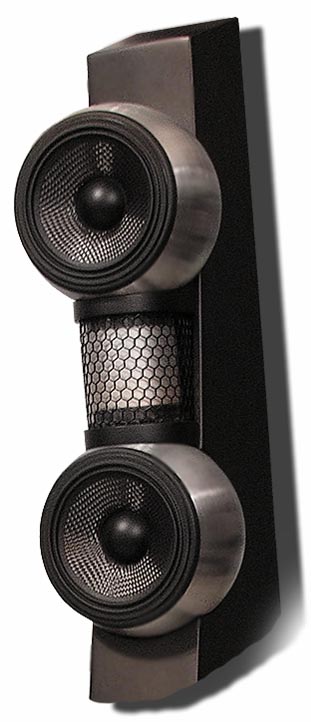|
|
|
|
|
This review page is supported in part by the sponsor whose ad is displayed above
|
|
 |
|
One day following a listening session utilizing the speaker level inputs at the bass amp, I shut off my main amplifier. Unexpectedly, the Ref 3s' woofers took off on their own to produce a loud bass drone that shook my walls. Lunging for the power switch on the bass amp, I silenced the speakers. To make a long story short, it was determined that once the main amplifier is shut down (but remaining connected to the bass amp through the speaker's first voice coil), the woofer becomes microphonic as will any large diaphragm when you think about it. As with any microphone, as the diaphragm gets excited by external vibrations, it sends a signal back through the voice coil to return to the bass amplifier. This sets up a small feedback loop that amplifies this retrograde signal with each successive cycle. Things go into oscillation. There are two easy ways to avoid this feedback. Use the preamp level inputs (a fine option for those who don't swap main amplifiers on a regular basis) or simply remember to turn the bass amplifier off before your main amplifier. Problem solved. Further inducement to use the low-level connection is that the S.A. also incorporates the same auto-on circuit found on most subwoofers. That means the user never has to touch the power switch on the S.A, ever. The bass amp also has a remote trigger input on the rear apron, allowing it to get its turn-on cue from another, similarly equipped component.
|
|
 |
|
|
For those not yet familiar with the original Ref 3, I suppose a few words of description are in order. Upon receipt of the speaker, I was surprised at its relatively diminutive stature despite having read all the reviews. It stands a mere 36.25 inches tall before the installation of the included 2-inch spikes. At its base, it's 8 inches wide but most of the speaker is considerably more scant. Said base is 14 inches deep but again, most of the speaker is considerably less massive. Yet it weighs in at a solid 47 pounds. I call 47 pounds solid? Indeed. Lifting this little speaker with its aluminum and stainless steel skeleton proves its deceptively solid and sturdy build. The pictures tell you everything else you need to know about its construction. The woofer is 10 inches in diameter. The Reference 3.1 is completely crossover-less from 150Hz to 35kHz. Each midrange is a 4-inch carbon fiber driver completely unencumbered by a crossover, operating from 150Hz on up to 3kHz. Also crossover-less is the CDTII tweeter, a capacitor by nature that automatically rejects low frequencies ensuring that no high-pass filter is needed. The CDTII operates from 3kHz to 35kHz. Available speaker finishes are black on black or black on stainless with black base. Cherry or natural maple bases are optional upgrades. Gallo quotes an impedance of 4 to 8 ohms for the top (main) binding posts, 4 ohms for the lower posts (second voice coil), an overall sensitivity of 88 dB/1w/1m and suggests a maximum power usage of 350 watts.
|
|
 |
 |
|
|
|
Also included with the Ref 3.1 is a very smart cage of sorts that is completely wrapped in an acoustically transparent knit. If you prefer the looks of the speaker with the grill, you lower it from the top down onto the |
|
speaker and bolt it to the speakers' spine at the rear. When I look at the speaker with the grill on, I'm further reminded of the Dahlquist connection.
Wow. That's probably the longest intro I've ever written for a review yet. That's because there's a lot of technology behind the seemingly simple Ref 3.1. The good news is that once the speakers are set up, all of that technology is completely invisible. In day-to-day use, these speakers are uncommonly simple to use. That's one of my favorite aspects of the Ref 3.1s. They're small. They don't dominate a room. Despite unusually wide treble dispersion, they are mono-polar. There's no active rear wave to necessitate undue concern over rear reflections. There's no rearward port either. Really simple.
|
|
 |
|
However, they do lose some of that air of simplicity once the optional S.A bass amplifier enters the picture. Unless you're very familiar with the use of subwoofers, you may require a little help from your dealer to get every iota of performance of which this system is capable. That's because the S.A. offers an unusual capacity to optimize in-room bass response. The flipside? It also offers an unusually large array of options whereby to truly screw things up. That's just the way it is, folks. But with the exception of the two volume controls, the good news is that the other controls are flush-mounted to put them out of reach of unwelcome prying hands. Once you get the controls dialed in, you can tweak the volume from time to time but everything else (low-pass frequency, phase and boost) should stay put. That said, I must hasten to add that the S.A. amplifier, once properly adjusted, works just as advertised.
If you're considering the Ref 3.1 for a home theater system, the S.A. amplifier is a no-brainer. It arms the 3.1 with an astounding degree of muscle plus the flexibility to dial in just about any degree of bass you'll likely desire. Regardless, after living with the S.A. amplifier for several months, I still consider it very much an option - a nice option to be sure but the bass provided by the Ref 3.1 is so darned good all by itself that for most of us not requiring a regular diet of cannon blasts or foundation-rumbling pipe organ, the Ref 3.1 offers an unusually satisfying amount and quality of bass. In fact, for this reason alone the 3.1s are the answer to something I've been contemplating for a long time.
|
|
| When you look at most speaker lines, two things happen as you move up. First, the dearer models utilize better drivers for a higher level of sound reproduction. Simultaneously, the enclosures get larger as do the woofers. By the time you near the top of the line, you’ve got a speaker |
|
that sounds fantastic but is so large and prodigiously endowed in the bass that it can't be used in small rooms. For a long time, I've been wondering why nobody produces a SOTA speaker designed for small rooms. And I'm not talking about monitors. I'm talking about a speaker that gives near full-range bass reproduction and works well with small rooms by not overloading them. There aren't many (if any) speakers that can produce 34Hz (let alone 22Hz) in a small room without creating all manner of problems. Well, the Gallos do that kind of bass without the problems and for considerably less money than comparable monitors that won't touch them in the bass.
|
|
 |
|
|
Am I seriously calling the Ref 3.1 a state-of-the-art loudspeaker designed for small rooms? You bet. In my experience, the Gallo is the only speaker that combines all the bass properties described with one of the most musically involving personalities I've ever experienced. To be honest, when Srajan went ape over the original Ref 3 and created the first-ever Lunar Eclipse award for it, I really had to wonder whether this little speaker could be that good. Once my pair was broken in and tethered to some really good front-end electronics, I understood exactly why Srajan was so impressed. Now I had to hand it to him for having the guts to allow himself to go so overboard on such an inexpensive speaker. Good for him. Let me just say that these speakers are every bit as good as Srajan said they are. Though I have no idea how much improved the 3.1 is over the Ref 3 he reviewed, everything he said applies in spades to the 3.1.
|
|
 |
|
 |
|
| Unlike every other review of the speakers I've read, Srajan went into detail about his favorite aspect of their performance - their speed. These speakers clearly demonstrate Anthony Gallo's long-time fascination with ribbons and electrostatics. They demonstrate why some listeners accept nothing but phase and time-accurate designs. Their largely crossover-less concept coupled to their physical time alignment makes them an incredibly fast-sounding |
|
| speaker to reveal levels of microdynamics that makes every stand-mounted speaker with any real bass at all sound slow and sluggish by comparison. Indeed, there are monitors like those from JMlabs for instance that sound as fast as the Gallos yet do so at the expense of body, warmth and bass. The Gallos deliver that speed and incisiveness with the kind of body and warmth that makes them uncommonly musical and involving. Listen to GRP's Live In Session [GRP A-1023] to see what I mean. Ignore for a moment the wall-to-wall stage populated by performers and concentrate on the lightning-fast percussion, particularly on "Oasis" and "The Rit Variations". The Gallos pressurize the room as they produce both the power and the weight of the drums with uncanny speed and dexterity. |
|
|
|
 |
|
|
|
 |
|
 |
|
|
|
|
|
|
|
|
|
|
|